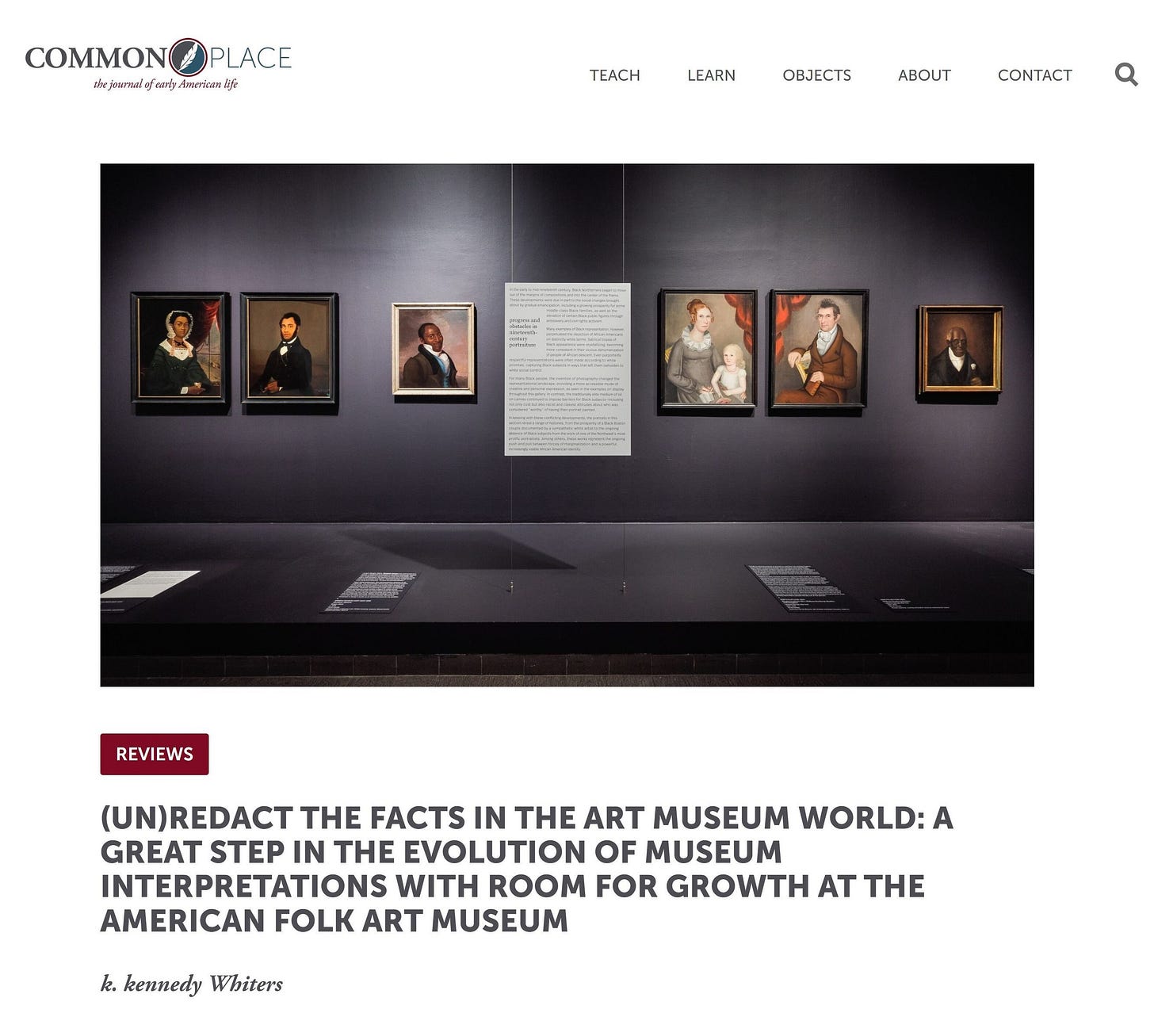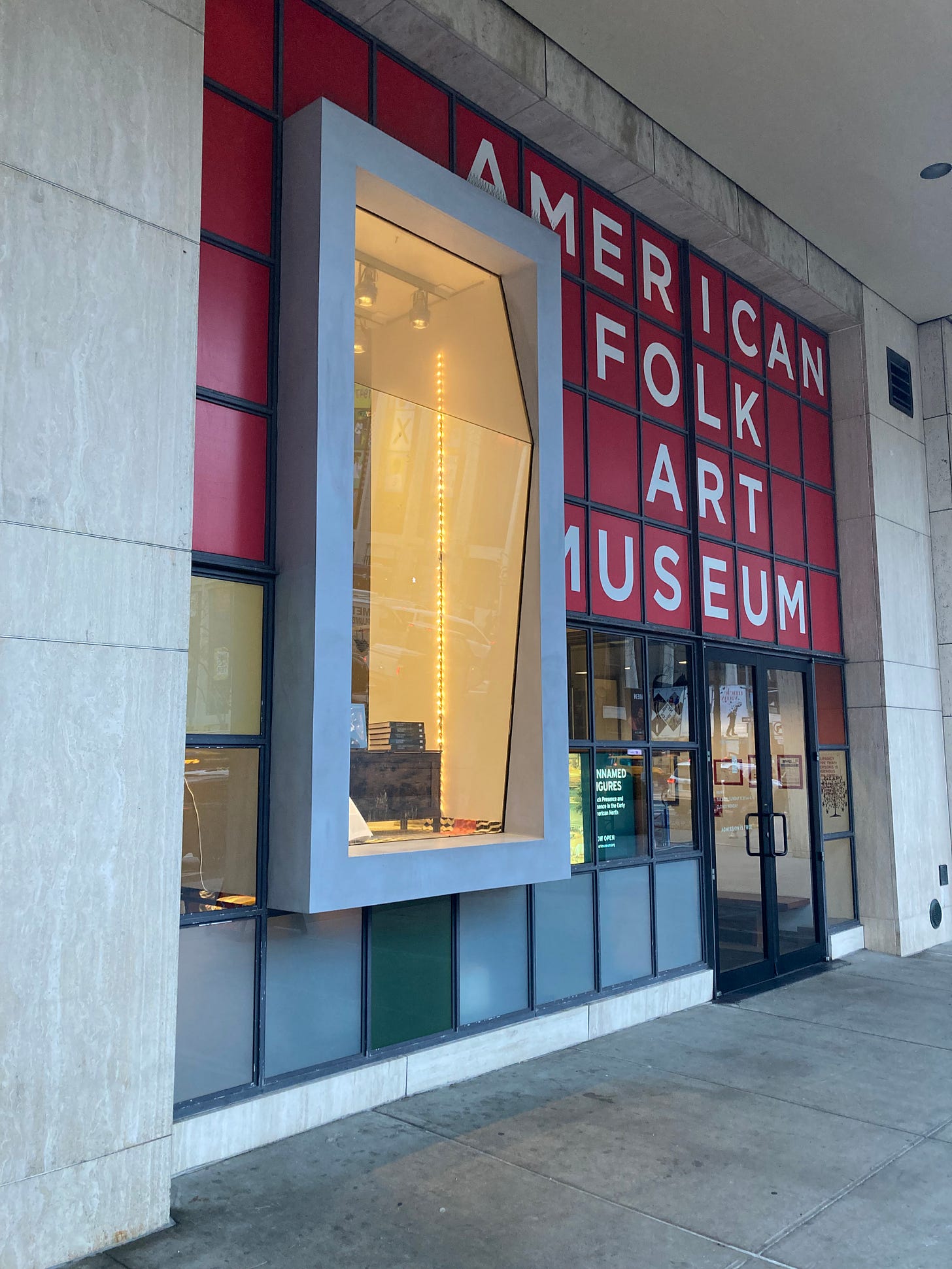My First Academic Journal Publication
a Call to Action to Museums and their Exhibit Interpretations to (un)Redact the Facts
Prefer to listen to this essay instead? Click here and copy and paste the link to this article into the site’s prompt.
Very pleased to share my first publication in an academic journal:
Thank you to Commonplace: the Journal of American Life for publishing my review of the American Folk Art Museum exhibit, “Unnamed Figures: Black Presence and Absence in the Early American North (November 15, 2023, to March 24, 2024).” Thank you to the American Folk Art Museum (AFAM) of New York City for providing a few images from the exhibit that appear in the review. AFAM offered to share images from the exhibit with Commonplace for a review of the exhibit. Glad to be a part of this tri-part collaboration.
In the review, I elaborate on this question:
“Can an exhibit practice truth and reconciliation if it does not name the specific people or race of people who redacted the facts of exhibits in the past?”
A quote from the review:
“Thinking back on the exhibit, I love how the curators concluded it with a statement on Black people’s desire to control or reclaim the narrative about them.”
As I sit and reflect on this moment of publication, I think back to 2012, when I began my post-grad school professional career in Seattle. While searching for my first full-time job at an architecture firm, I volunteered with King County’s 4Culture in their preservation department and earned $25 per review of cultural events they funded with arts and heritage grants. Now, twelve years later, a review I wrote of an art exhibit is in an academic journal. Neat.
...
The significance of publication is not lost on me. A 2023 study highlighted the inequality in the publication of articles authored by members of under-represented, historically neglected groups, i.e., Black, Indigenous, and Latine people. More on this topic:
:: If you have access via an institution, you can read about the bias in the Nature.com article "Racial inequalities in journals highlighted in giant study: Discrimination against members of under-represented groups in academic publishing leads to lower citation rates, fewer editorial-board positions and longer manuscript-review periods."
:: Brunette Katsandegwaza, PhD on LinkedIn: "Racial disparities in academic publishing"
:: The Journal of Racial and Ethnic Disparities: "The Under-representation and Stagnation of Female, Black, and Hispanic Authorship in the Journal of the American Medical Association and the New England Journal of Medicine"
...
Although it is not financially compensated work, which is common for academic publications, I am thankful to Commonplace for their uncommon practice of allowing their contributors to republish their essays/reviews, etc., after 3-months of publication in the journal. For those new to Commonplace, it is an online journal sponsored by the American Antiquarian Society and the Omohundro Institute of William & Mary College. From the About section of their website:
“Welcome to Commonplace, a destination for exploring and exchanging ideas about early American history and culture. A bit less formal than a scholarly journal, a bit more scholarly than a popular magazine, Commonplace speaks—and listens—to scholars, museum curators, teachers, hobbyists, and just about anyone interested in American history before 1900. It is for all sorts of people to read about all sorts of things relating to early American life—from architecture to literature, from politics to parlor manners. It’s a place to find insightful analysis of early American history as it is discussed in scholarly literature, as it manifests on the evening news, as it is curated in museums, big and small; as it is performed in documentary and dramatic films and as it shows up in everyday life."
"Sponsored by the American Antiquarian Society, founded by editors Jane Kamensky and Jill Lepore, and designed by John McCoy, Common-Place: The Journal of Early American Life is the product of an amazing team of editors and institutions. Over nearly two decades, the journal has been published in partnerships with Florida State University, the University of Oklahoma, the Gilder Lehrman Institute of American History, and the University of Connecticut.”
...
Last, a few special thanks:
:: to Commonplace Editor Joshua Greenberg and the editorial board of academics from across the country and staff. Joshua answered my questions and provided image resources, including connecting me with American Folk Art Museum staff for images, and facilitated a smooth editing process for my offering.
:: to Kathryn Anthony, PhD., the first woman to earn tenure at the School of Architecture at the University of Illinois at Urbana-Champaign. I was one of the students she encouraged and mentored in submitting an essay we submitted for her “Race and Architecture” course to a journal. Because of her encouragement, I saw what was possible for a classroom assignment.
:: And of course, I thank the writing genes in me – “I get it from my momma.” Thank you.
(un)Redact the Facts is an initiative of wrkSHäp | kiloWatt, a Black woman-owned historic preservation studio owned and operated by k. kennedy Whiters, AIA, that specializes in historic preservation, owner’s representation/construction project management, and history communications/storytelling. Through the power of honest history storytelling, it is ancestral, healing work for past, present, and future generations.
k. kennedy Whiters, AIA is an architect with licenses to practice in New York and Washington State, a published writer, an artist, and a business owner. She was a 2008 recipient of the National Trust for Historic Preservation’s Mildred Colodny Fellowship. In 2021, she founded Black in Historic Preservation, (un)Redact the Facts, and Beyond Integrity in (X). The latter was a national historic preservation conference that focused on the topic of architectural integrity of historic landmarks. She’s been known to hug a tree and a building or two.





